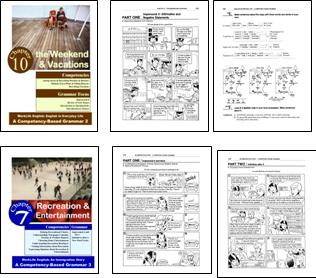1
/
of
1
Work/Life English
D-11.03 Use “Impersonal” IT vs THERE in Affirmative & Negative Statements & (Tag) Questions (Not) Followed by Infinitives
D-11.03 Use “Impersonal” IT vs THERE in Affirmative & Negative Statements & (Tag) Questions (Not) Followed by Infinitives
Regular price
$4.00 USD
Regular price
Sale price
$4.00 USD
Unit price
/
per
Parts One & Two of Chapter 10 (“the Weekend & Vacations”) of WorkLife English Grammar 2: English in Everyday Life, pages 154-161. Parts One & Two of Chapter 7 (“Recreation & Entertainment”) of WorkLife English Grammar 3: An Immigration Story, pages 113-120
16 pages
Who It’s For: (Self) Teachers & Helpers at (High) Beginning to Intermediate Language-Proficiency Levels & Beyond
Why It’s Useful: Except in “Imperatives / Directives,” English sentences usually have expressed subjects. When not used as pronouns or adverbs of place, the “fillers” it and there sometimes “fill” a grammatical-subject slot, delaying the occurrence of a (singular or plural) noun or an adjective (+ infinitive subject) in the sentence. These excerpts from the second and third levels of a Competency-Based Grammar series offer sentence patterns, rules + tips, and some in-context practice.
What You’ll Do:
[1] In the 2-part, 8-page extract from Chapter 10 (“Recreation & Entertainment”) of WorkLife English Grammar 2, take in the uses of “Impersonal it—in various tense forms—in the page 155 Strip Story “It’s not going to be a good day.” In subsequent A-*E Exercises, compare the positions / functions of Impersonal It (mostly in sentences about time, distance, weather) with those of “regular” subjects. Get used to short answers and “Tag-Questions” with this grammar.
[2] In Part One of Chapter 7 (“the Weekend & Vacations”) of WorkLife English Grammar 3, review the functions of “Impersonal It vs. There” —in three time frames—in the page 114 Strip Story “It’s the weekend, and there’s nothing to do.” In the Statement- & Question-Pattern Boxes and Exercises A-*D, practice these sentence structures. Then in Part Two (“There’s nothing to watch on TV—and it’s too expensive to go out.”), add “Delayed Infinitive Subjects after there vs. it” to your grammatical repertoire.
Couldn't load pickup availability


